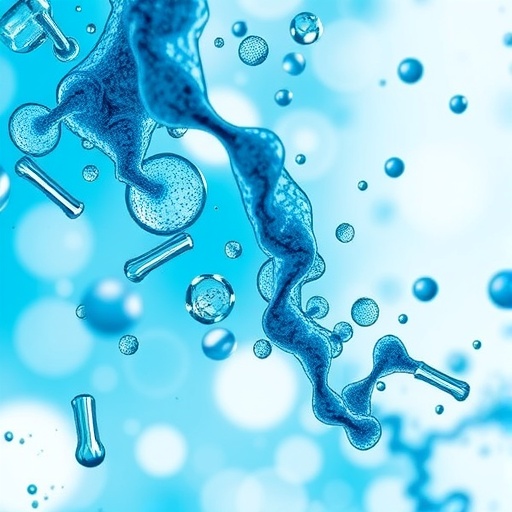In a groundbreaking metagenomic study, researchers from Türkiye have unveiled a complex ecosystem within the wastewater generated by a ceramic factory. This research highlights the intricate interplay between bacteria and viruses, specifically phages, in an environment heavily impacted by industrial activities. As industrial waste becomes an ever-growing concern for environmental health, the insights gained from this study pave the way for better understanding and potentially mitigating the adverse effects associated with wastewater management.
The investigative team, led by esteemed scientists E. Aydin, A. Karaynir, and R. Ozkan, has painstakingly analyzed the bacteriome and phageome present in the factory’s wastewater system. Their approach combined advanced metagenomic techniques with meticulous sampling and bioinformatics analysis, yielding a comprehensive view of microbial diversity. What sets this research apart is its focus on how industrial processes influence microbial populations within wastewater.
The ceramic industry is known for producing significant volumes of wastewater laden with heavy metals, clays, and other chemicals that can alter microbial ecosystems. Within this context, bacteria and their bacteriophages play critical roles. Bacteria can adapt to harsh conditions, while phages, their viral counterparts, help regulate bacterial populations and can even contribute to the genetic diversity of these microbes through horizontal gene transfer. The balance between these organisms thus serves as a bioindicator of the ecological health of wastewater environments.
The study found a remarkable array of bacterial species within the wastewater, as identified through high-throughput sequencing methods. These species included not only common environmental bacteria but also those that are rarely documented in industrial waste settings. The presence of these diverse microbes suggests that they possess unique metabolic capabilities that allow them to flourish in polluted environments—a phenomenon that could provide biotechnological insights for future wastewater treatment processes.
In addition to exploring the bacteriome, the researchers also mapped the phageome—essentially the collection of bacteriophages residing within the same wastewater. This aspect of the study was particularly noteworthy because phages have been largely underrepresented in discussions concerning industrial waste. The researchers discovered high levels of viral diversity, including several novel phage types, which are potentially poised to interact with the heavily populated bacterial communities. Understanding phage dynamics can not only be crucial for grasping bacterial evolution in contaminated environments but may also open avenues for phage therapy applications in microbial control.
The implications of this research extend beyond merely cataloging microbial life forms. It poses significant questions regarding the ecological resilience of microbial communities in severely altered habitats, such as those influenced by industrial overflow. The findings provoke thought about how such microbial dynamics could influence biogeochemical cycles and the subsequent effects on local biodiversity.
As the team delved deeper into the functional capacities of the identified microorganisms, they also recognized the potential for bioremediation applications. Certain bacteria with enzymatic pathways capable of degrading contaminants in the wastewater were isolated, presenting opportunities for leveraging these organisms in engineered solutions aimed at reducing industrial effluent toxicity. In this light, metagenomic analyses transform from basic scientific inquiries into practical tools for environmental sustainability.
Moreover, the study raises awareness about the necessity for comprehensive monitoring of industrial wastewater at a microbial level. As regulatory bodies increasingly emphasize the need for vigilant waste management practices, the insights from this research underscore the potential of metagenomics as a critical tool for assessing ecological risks. Future regulations may need to include guidelines that consider not just the chemical but also the microbial constituents of wastewater streams.
In reflecting on the broader repercussions of their findings, the researchers emphasize the importance of fostering collaboration between microbiologists, environmental scientists, and industry stakeholders. A multidisciplinary approach could lead to more comprehensive environmental strategies that not only focus on immediate contamination issues but also on long-term ecological impacts resulting from industrial waste.
The significance of this research rests not only in contributing to scientific literature but also in its potential to influence environmental policies and practices in industrial sectors. By demonstrating the intricate relationships between bacteria, phages, and their environments, the study opens new avenues for research and innovation that could lead to cleaner production processes and improved waste management strategies.
Ultimately, Aydin, Karaynir, and Ozkan have shed light on a critical yet under-explored aspect of industrial wastewater—the microbial communities that exist within it, their resilience, and their functionality. As industries continue to evolve and face scrutiny over environmental impacts, studies like this one will undoubtedly play an essential role in guiding sustainable practices moving forward. By embracing the complexities of microbial life, we might just find the solutions needed to tackle one of the most pressing issues of our time: the challenge of managing industrial waste responsibly.
Subject of Research: Metagenomic analysis of bacteriome and phageome in industrial wastewater
Article Title: Metagenomic analysis of bacteriome and phageome of wastewater from a ceramic factory in Türkiye
Article References:
Aydin, E., Karaynir, A., Ozkan, R. et al. Metagenomic analysis of bacteriome and phageome of wastewater from a ceramic factory in Türkiye. Int Microbiol (2025). https://doi.org/10.1007/s10123-025-00753-5
Image Credits: AI Generated
DOI:
Keywords: wastewater, metagenomics, bacteriome, phageome, ceramic factory, industrial pollution, microbiomes, environmental sustainability, bioremediation, microbial diversity.




